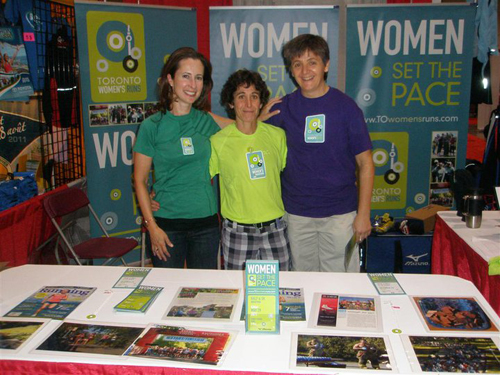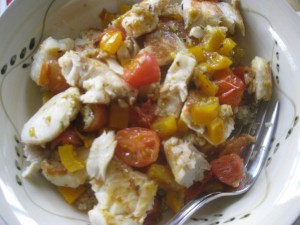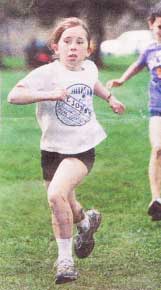
By Karen Karnis
Cory Freedman wants to be clear: while there are no awards for them in the Toronto Women’s Run series, men are certainly welcome. It’s just that, with the number of female runners rising year after year, Freedman saw the potential for a different kind of event. “Sixty percent of finishers of all race distances from the half-marathon and shorter are women,” she says. “In the early 1990s, there had been a race series geared towards women. Around the year 2000, I thought, there is a need for this now more than ever.”
So, what makes a race that is geared towards women different? Freedman describes the Toronto Women’s Runs as friendly and non-intimidating, yet highly competitive. “There is a universality to these events,” she says. “We have the fastest women in the country and absolute beginners. We have youth – moms with their daughters and their friends.”
Freedman tells the story of a girls’ hockey team whose coach had them train for the 5K in October 2010. They complained about it, but they all trained and finished the event. “This year,” says Freeman, “they approached their coach and said ‘we want to do this again this year!’”
So what goes into an event that has women of all ages and abilities coming back for more? “I wanted it to be cool enough that I would want to do with my friends,” says Freedman. Everyone on the race committee is a runner, and they have high standards. “They take pride in delivering great races. We’re all about going above and beyond to deliver great customer service,” she adds.
The series is known for stellar organization – everyone knows exactly what they’re supposed to do, and the events are well executed. “We have great volunteers. Most of them are runners who want to give back, so they really get it,” says Freedman. Of all the questions on their post-race satisfaction surveys, runners give the highest scores to the volunteers. They also strive to leave Sunnybrook Park cleaner than when they found it, leading to comments from city staff that they’re happy to have the series as guests.
To put together a top-notch event, Freedman and her crew look at what they would want to see at a race and focus on everything down to the finest details. Of course there are the obvious features: the chocolate on course, the firefighters handing out water, the medal that you can wear as a necklace; but it doesn’t end there.
“There are always line ups for washrooms pre-race, so we have a volunteer stationed there to keep the line moving – she looks for the empty port-o-lets with no line-up and points them out,” says Freedman. And at the end of the race, when you least feel like standing in a long line up again, pre-bagged food is handed out, keeping lines short and moving quickly. There is always a change tent so runners who don’t want to go home in wet clothes have some privacy, rather than trying to duck behind trees, towels or each other.
The ongoing support of Mizuno also goes a long way to help make each event a success. “The thing I love about working with Mizuno is that they are as committed and engaged as I am,” says Freedman. “They knew what we knew and got involved with us the first year – it’s more of a partnership than a sponsorship,” she adds.
Of course, the runners are not the only people who benefit. In the 2011 season, the series raised $50,000 for the Pediatric Oncology Group of Ontario (POGO). Among other things, POGO works to ensure that all children with cancer have access to state of the art treatment, and assists families of childhood cancer patients financially.
With Freedman’s extensive experience in the charitable sector, one might think it would have been hard for her to choose a charitable partner. After all, as the former Director of Events for the Canadian Breast Cancer Foundation, she guided the CIBC Run for the Cure. She also launched and implemented Team Diabetes. However, she says that POGO was an easy choice. “The thing I love about POGO is that they’re really nimble,” says Freedman. “A family with a child in cancer treatment sees household income drop by about a third, and POGO makes sure the money gets to families who need it right away.”






 As you plan further away from race day the training should become more general. An athlete preparing for a marathon should focus on short efforts significantly above goal race pace combined with long steady-state runs slightly below race pace. These efforts will build the support for completing the marathon-specific workouts that are emphasized closer to race day. Likewise, a shorter distance runner may focus on longer steady-state runs well below race pace, and efforts slightly above goal race pace. You will notice that I used the terms “well below” and “slightly above” regarding shorter-distance races and may be wondering why. The answer is that because these races are run at a higher percentage of an athlete’s maximum speed it is simply impossible to run proper workouts at the same relative difference in speed as a person training for a marathon would.
As you plan further away from race day the training should become more general. An athlete preparing for a marathon should focus on short efforts significantly above goal race pace combined with long steady-state runs slightly below race pace. These efforts will build the support for completing the marathon-specific workouts that are emphasized closer to race day. Likewise, a shorter distance runner may focus on longer steady-state runs well below race pace, and efforts slightly above goal race pace. You will notice that I used the terms “well below” and “slightly above” regarding shorter-distance races and may be wondering why. The answer is that because these races are run at a higher percentage of an athlete’s maximum speed it is simply impossible to run proper workouts at the same relative difference in speed as a person training for a marathon would.
 Josh Seifarth
Josh Seifarth


 Most runners are fascinated with running times. While some of us get excited about seeing or meeting movie stars, I get excited about being in the presence of really fast runners.
Most runners are fascinated with running times. While some of us get excited about seeing or meeting movie stars, I get excited about being in the presence of really fast runners. Our Magazine
Our Magazine Previous Release
Previous Release
